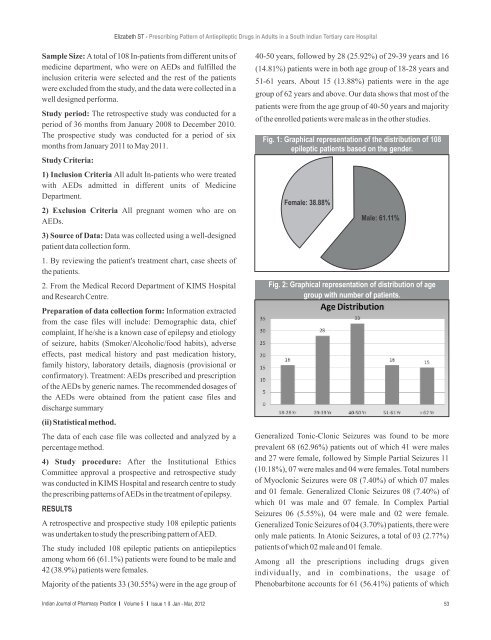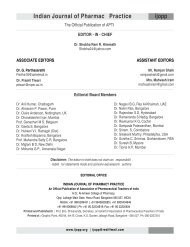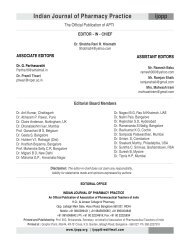Prescribing Pattern of Antiepileptic Drugs in Adults in a South Indian ...
Prescribing Pattern of Antiepileptic Drugs in Adults in a South Indian ...
Prescribing Pattern of Antiepileptic Drugs in Adults in a South Indian ...
You also want an ePaper? Increase the reach of your titles
YUMPU automatically turns print PDFs into web optimized ePapers that Google loves.
Elizabeth ST - <strong>Prescrib<strong>in</strong>g</strong> <strong>Pattern</strong> <strong>of</strong> <strong>Antiepileptic</strong> <strong>Drugs</strong> <strong>in</strong> <strong>Adults</strong> <strong>in</strong> a <strong>South</strong> <strong>Indian</strong> Tertiary care HospitalSample Size: A total <strong>of</strong> 108 In-patients from different units <strong>of</strong>medic<strong>in</strong>e department, who were on AEDs and fulfilled the<strong>in</strong>clusion criteria were selected and the rest <strong>of</strong> the patientswere excluded from the study, and the data were collected <strong>in</strong> awell designed performa.Study period: The retrospective study was conducted for aperiod <strong>of</strong> 36 months from January 2008 to December 2010.The prospective study was conducted for a period <strong>of</strong> sixmonths from January 2011 to May 2011.Study Criteria:1) Inclusion Criteria All adult In-patients who were treatedwith AEDs admitted <strong>in</strong> different units <strong>of</strong> Medic<strong>in</strong>eDepartment.2) Exclusion Criteria All pregnant women who are onAEDs.3) Source <strong>of</strong> Data: Data was collected us<strong>in</strong>g a well-designedpatient data collection form.1. By review<strong>in</strong>g the patient's treatment chart, case sheets <strong>of</strong>the patients.2. From the Medical Record Department <strong>of</strong> KIMS Hospitaland Research Centre.Preparation <strong>of</strong> data collection form: Information extractedfrom the case files will <strong>in</strong>clude: Demographic data, chiefcompla<strong>in</strong>t, If he/she is a known case <strong>of</strong> epilepsy and etiology<strong>of</strong> seizure, habits (Smoker/Alcoholic/food habits), adverseeffects, past medical history and past medication history,family history, laboratory details, diagnosis (provisional orconfirmatory). Treatment: AEDs prescribed and prescription<strong>of</strong> the AEDs by generic names. The recommended dosages <strong>of</strong>the AEDs were obta<strong>in</strong>ed from the patient case files anddischarge summary(ii) Statistical method.The data <strong>of</strong> each case file was collected and analyzed by apercentage method.4) Study procedure: After the Institutional EthicsCommittee approval a prospective and retrospective studywas conducted <strong>in</strong> KIMS Hospital and research centre to studythe prescrib<strong>in</strong>g patterns <strong>of</strong> AEDs <strong>in</strong> the treatment <strong>of</strong> epilepsy.RESULTSA retrospective and prospective study 108 epileptic patientswas undertaken to study the prescrib<strong>in</strong>g pattern <strong>of</strong> AED.The study <strong>in</strong>cluded 108 epileptic patients on antiepilepticsamong whom 66 (61.1%) patients were found to be male and42 (38.9%) patients were females.Majority <strong>of</strong> the patients 33 (30.55%) were <strong>in</strong> the age group <strong>of</strong>40-50 years, followed by 28 (25.92%) <strong>of</strong> 29-39 years and 16(14.81%) patients were <strong>in</strong> both age group <strong>of</strong> 18-28 years and51-61 years. About 15 (13.88%) patients were <strong>in</strong> the agegroup <strong>of</strong> 62 years and above. Our data shows that most <strong>of</strong> thepatients were from the age group <strong>of</strong> 40-50 years and majority<strong>of</strong> the enrolled patients were male as <strong>in</strong> the other studies.Fig. 1: Graphical representation <strong>of</strong> the distribution <strong>of</strong> 108epileptic patients based on the gender.Female: 38.88%Male: 61.11%Fig. 2: Graphical representation <strong>of</strong> distribution <strong>of</strong> agegroup with number <strong>of</strong> patients.Generalized Tonic-Clonic Seizures was found to be moreprevalent 68 (62.96%) patients out <strong>of</strong> which 41 were malesand 27 were female, followed by Simple Partial Seizures 11(10.18%), 07 were males and 04 were females. Total numbers<strong>of</strong> Myoclonic Seizures were 08 (7.40%) <strong>of</strong> which 07 malesand 01 female. Generalized Clonic Seizures 08 (7.40%) <strong>of</strong>which 01 was male and 07 female. In Complex PartialSeizures 06 (5.55%), 04 were male and 02 were female.Generalized Tonic Seizures <strong>of</strong> 04 (3.70%) patients, there wereonly male patients. In Atonic Seizures, a total <strong>of</strong> 03 (2.77%)patients <strong>of</strong> which 02 male and 01 female.Among all the prescriptions <strong>in</strong>clud<strong>in</strong>g drugs given<strong>in</strong>dividually, and <strong>in</strong> comb<strong>in</strong>ations, the usage <strong>of</strong>Phenobarbitone accounts for 61 (56.41%) patients <strong>of</strong> which<strong>Indian</strong> Journal <strong>of</strong> Pharmacy Practice Volume 5 Issue 1 Jan - Mar, 2012 53
















